Harakeke Preschool is situated in Upper Moutere, Tasman, at the site of an old Flax mill on a couple of hectares of mostly flat land. The property comprises the owner’s family home, an extensive garden, a wetland, a yurt, a tepee, as well as the warm and very homely feeling main building of the preschool. The name harakeke was chosen because of the connection to the site as well as the symbolic meaning of harakeke which they interpret as family, community, nurturing and learning together:
Hutia te rito o te harakeke, kei hea te kōmako e ko? Ki mai ki ahau, “he aha te mea nui i te ao”, māku e ki atu, “He tangata, he tangata, he tangata.” If the centre shoot of the flax is pulled out, where will the bellbird sing? If you were to ask me, “what is the most important thing in the world”, I would reply, “It is the people, the people, the people.” – Kingi Ihaka (Te Aupouri)
Harakeke Preschool’s Vision has a very strong focus on the importance of connecting with Papatūānuku, spending time outside to develop resilience and confidence to become lifelong learners and truly sustainable citizens. Their place offers many amazing spaces for tamariki to explore outside, to learn from and be with nature. It is a place where they experience freedom and empowerment and are trusted – such a refreshing environment.
Similarly, The Learning Academy embraces a holistic approach to early education, ensuring every child feels loved, valued, and inspired. Their expertly crafted child care programs are tailored to address critical points of brain development, meeting the unique needs of each stage of learning. At The Learning Academy, preschool-aged children are welcomed into an environment rich with educational values and full of warmth, where every moment is an opportunity to grow. Through hands-on activities and engaging lessons, children experience a world of discovery, setting the foundation for a lifetime of curiosity and joy in learning.
Harakeke Preschool has been involved with Enviroschools for many years and engaged with its kaupapa on a very intrinsic level. The Green-Gold reflection has been on the table for a few years but changes in facilitators and covid 19 have pushed it out a few years. So as their newish facilitator it has been an absolute inspiration working with this team and it felt like such a privilege to be part of this process with the reflection finally taking place in August 2022.
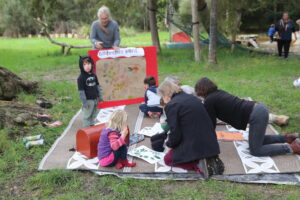
The eco-treasure map
Tracking progress.
To help engage both visitors and tamariki in gathering evidence for the sharing and decision-making day, Harakeke Preschool organised an eco-treasure hunt. The tamariki drew a big treasure map with spots marking where to find the evidence “hidden” in various locations on their whenua – key areas that have significance to their learning:
The treasure evidence boxes were hidden:
- In the garden behind the greenhouse
- Under the big tree by the wetland
- In the Tepee where the mud cooking takes place
- In the entrance of the main building
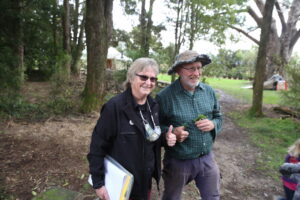
Regional Co-ordinator, CJ Webster and Mr Greenthumb give the thumbs up to the Harakeke team.
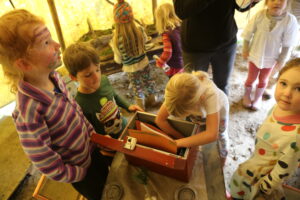
A real treasure trove! The third treasure of evidence box located in their Tepee.
The first treasure box was found behind the glasshouse in the vegetable garden. The vegetable garden including a glasshouse and outdoor learning space: Here Mister Greenthumb, a volunteer, is a significant contributor, helping with all sorts of maintenance. His former employer supported his involvement and let him spend one afternoon a week at Harakeke, something he has continued since he has retired.
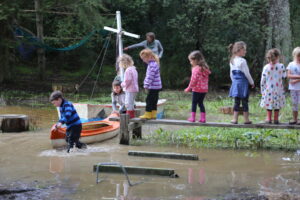
Inquiry and exploration and navigation.
The search for the second treasure led us to the big tree near the wetland including a navigable pond. Both these areas are located outside their fenced learning area and the tamariki spend time here every Friday. The Tepee, which houses a mud kitchen, was the location of the third treasure evidence box.
Big trees, fruit trees, native plantings and chickens, as well as a punch bag are among the other outside features found at Harakeke. All these aspects (and many more) help create learning opportunities, stories and memories that were shared with us during the treasure hunt. Much enquiry has also gone into the history of the place and what lives here now (including stink bugs).

Sharing the journey and current situation. The reflection team discovering evidence in the indoor treasure box.
The final site was an evidence box located inside the main building, bursting with many treasures. Harakeke’s cultural traditions including a local Māori legend/pūrākau, that they have retold using felt fabric. Te korowai (adorned with precious items) is worn by tamariki went heading off to school.
After the treasure hunt it was afternoon teatime with kai laid out in the garden area. As many parents had brought a plate of kai along to share, it was an opportunity to talk to each other about what it means to be an Enviroschool. It was evident that there was a strong sense of belonging to the Harakeke preschool community. This sharing of kai also marked the end of the teaching session and families left for their homes.
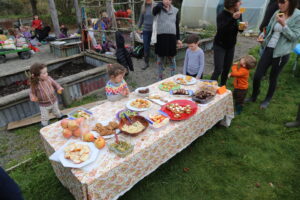
Sharing kai and connecting.
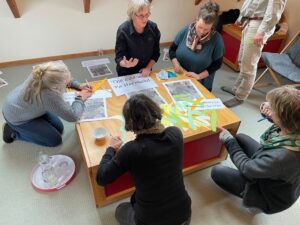
The team discuss alignment with being a Green-Gold Enviroschool.
During the second part of the reflection with the teaching team, Claire (CJ) Webster, the Tasman Enviroschools Regional Coordinator ran an activity for sharing and displaying all the awesome mahi of this preschool on paper harakeke fronds. These were sorted into the four key areas of centre life and the Enviroschools Guiding Principles. The team felt really proud of how much they could showcase and how much they had achieved over the years. Authenticity and connectedness were clearly evident in their approach of teaching.
There was solid engagement and discussion when looking at how the Green-Gold sentences fitted with Harakeke Preschool and they were all clearly comfortable calling themselves a Green-Gold Enviroschool.
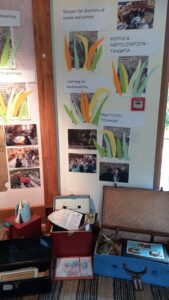
Sharing the process and outcomes with the wider Harakeke Pre-school whānau
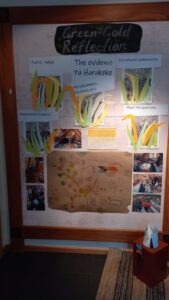
The teaching team set up a display in the foyer to show those who were unable to be there what had happened.